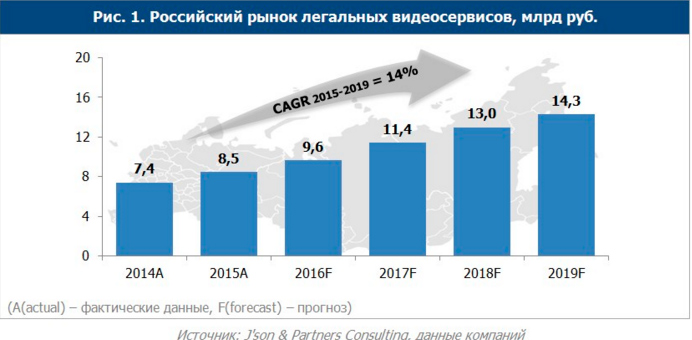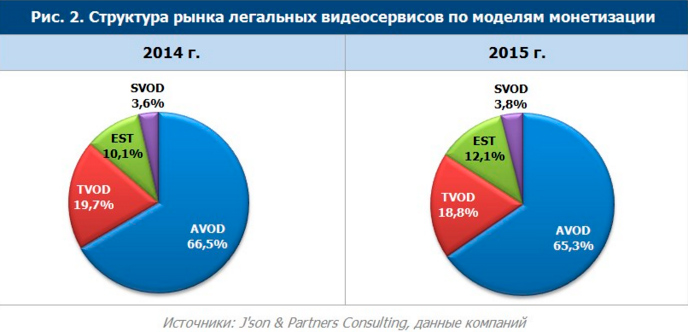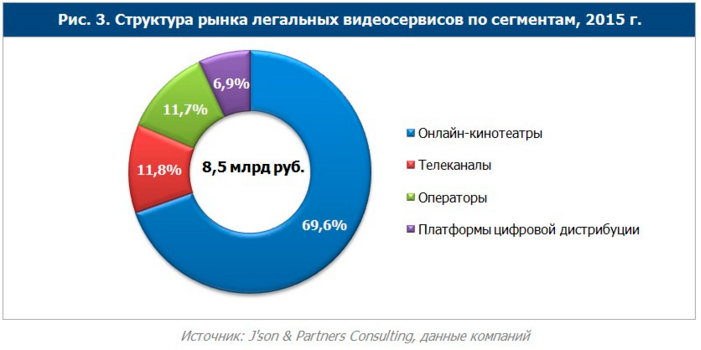Everything is fair: in 2015, the market of legal video services in Russia grew by 15%

According to the company J'son & Partners Consulting, the market volume of legal video services in Russia in 2015 grew by 15%. The researchers analyzed video services in Russia that provide access to legal content (VOD - video on demand) through the set-top box or via OTT (without being tied to the operator’s network).
At the end of 2015, the volume of the Russian market of legal video services reached 8.5 billion rubles. In 2015, the most common monetization model remained advertising ( AVOD ). According to J'son & Partners, AVOD will remain the absolute market leader, and until 2019 its share will not fall below 65%.
')

Online cinemas in the market lead in terms of revenue, in 2015 they earned 5.9 billion rubles. The main players sharply increased their revenues (by 50-70%), including through the development of paid services. This allowed some of them to declare an operating break-even.
TV channels occupy the second place with revenue of 1 billion rubles. This is still less than 1% of advertising revenue on television, but the rapid growth in the number of channels online and their income will continue, researchers believe.
Pay-TV operators from providing video on demand (Video on Demand) received 994 million rubles. Over time, for them it can be an important additional service.

Digital distribution platforms in 2015 earned on video on demand 581 million rubles. The introduction of VAT on the sale of digital content can slow down the development of this segment in the next few years. After all, market players will not be able to pay sales taxes without increasing the cost of content for users.
Due to the devaluation of the ruble and the growth of the world market at rapid rates in 2015, the share of the Russian market in the global volume decreased by half and amounted to 0.5%.The report of J'son & Partners Consulting notes that the entry of new major players into the Russian market is unlikely, but it is possible to strengthen the existing ones.
A prime example is the emergence of Netflix in Russia in early 2016. If a company conducts the Russification of the interface, revises the tariffs and replenishes the library with content that is in demand by the Russian user, then it can take a significant market share. “We hope that in Russia there will be more licensed content, and with the advent of Netflix, people will start to get used to the subscription consumption model,” said LG Electronics development manager for Smart TV in Russia, Vitaly Svistunov.
Among other key trends, J'son & Partners Consulting experts also name the expansion of cooperation between pay TV operators and online cinemas, as well as the production of their own content by video resources.
An important event in 2015 was the development of recommendations by many video services to users, researchers believe. Innovation will allow users to simplify the selection of content to view and increase the total viewing time. This, in turn, should lead to an increase in video service revenues.
According to 2014 data, watching TV shows via Smart TV and set-top boxes was a success for less than half of Russians. The most popular device remained the usual computer.
According to TMT-Consulting, in 2014, more than 20 legal OTT video services operated in Russia. For six players, the market share exceeded 5%. Okko and ivi.ru kept half the market for two.
Last year, the popularity of different types of OTT services in Russia was distributed as follows:

Sources: J'son & Partners Consulting
Source: https://habr.com/ru/post/299408/
All Articles